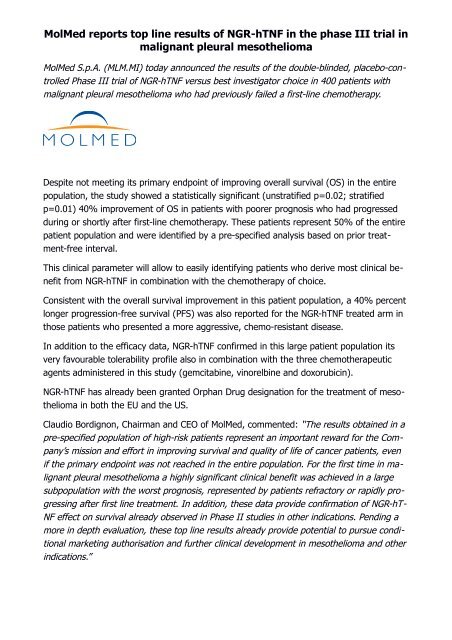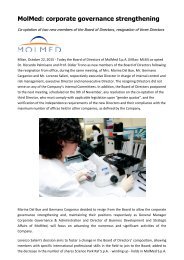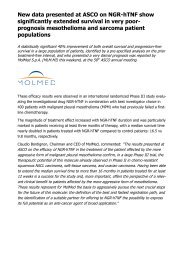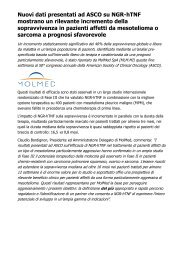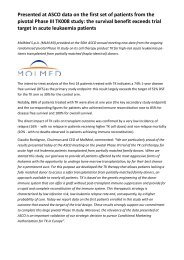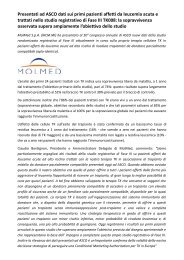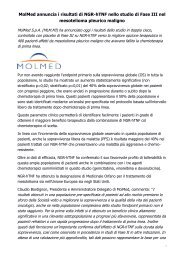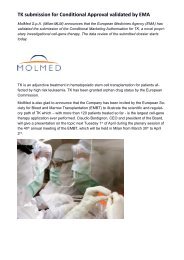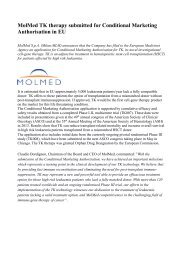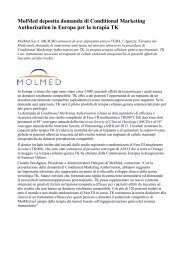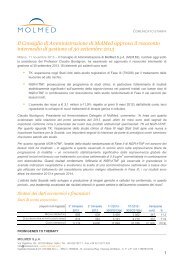MolMed reports top line results of NGR-hTNF in the phase III trial in malignant pleural mesothelioma
Create successful ePaper yourself
Turn your PDF publications into a flip-book with our unique Google optimized e-Paper software.
<strong>MolMed</strong> <strong>reports</strong> <strong>top</strong> <strong>l<strong>in</strong>e</strong> <strong>results</strong> <strong>of</strong> <strong>NGR</strong>-<strong>hTNF</strong> <strong>in</strong> <strong>the</strong> <strong>phase</strong> <strong>III</strong> <strong>trial</strong> <strong>in</strong><br />
<strong>malignant</strong> <strong>pleural</strong> meso<strong>the</strong>lioma<br />
<strong>MolMed</strong> S.p.A. (MLM.MI) today announced <strong>the</strong> <strong>results</strong> <strong>of</strong> <strong>the</strong> double-bl<strong>in</strong>ded, placebo-controlled<br />
Phase <strong>III</strong> <strong>trial</strong> <strong>of</strong> <strong>NGR</strong>-<strong>hTNF</strong> versus best <strong>in</strong>vestigator choice <strong>in</strong> 400 patients with<br />
<strong>malignant</strong> <strong>pleural</strong> meso<strong>the</strong>lioma who had previously failed a first-<strong>l<strong>in</strong>e</strong> chemo<strong>the</strong>rapy.<br />
Despite not meet<strong>in</strong>g its primary endpo<strong>in</strong>t <strong>of</strong> improv<strong>in</strong>g overall survival (OS) <strong>in</strong> <strong>the</strong> entire<br />
population, <strong>the</strong> study showed a statistically significant (unstratified p=0.02; stratified<br />
p=0.01) 40% improvement <strong>of</strong> OS <strong>in</strong> patients with poorer prognosis who had progressed<br />
dur<strong>in</strong>g or shortly after first-<strong>l<strong>in</strong>e</strong> chemo<strong>the</strong>rapy. These patients represent 50% <strong>of</strong> <strong>the</strong> entire<br />
patient population and were identified by a pre-specified analysis based on prior treatment-free<br />
<strong>in</strong>terval.<br />
This cl<strong>in</strong>ical parameter will allow to easily identify<strong>in</strong>g patients who derive most cl<strong>in</strong>ical benefit<br />
from <strong>NGR</strong>-<strong>hTNF</strong> <strong>in</strong> comb<strong>in</strong>ation with <strong>the</strong> chemo<strong>the</strong>rapy <strong>of</strong> choice.<br />
Consistent with <strong>the</strong> overall survival improvement <strong>in</strong> this patient population, a 40% percent<br />
longer progression-free survival (PFS) was also reported for <strong>the</strong> <strong>NGR</strong>-<strong>hTNF</strong> treated arm <strong>in</strong><br />
those patients who presented a more aggressive, chemo-resistant disease.<br />
In addition to <strong>the</strong> efficacy data, <strong>NGR</strong>-<strong>hTNF</strong> confirmed <strong>in</strong> this large patient population its<br />
very favourable tolerability pr<strong>of</strong>ile also <strong>in</strong> comb<strong>in</strong>ation with <strong>the</strong> three chemo<strong>the</strong>rapeutic<br />
agents adm<strong>in</strong>istered <strong>in</strong> this study (gemcitab<strong>in</strong>e, v<strong>in</strong>orelb<strong>in</strong>e and doxorubic<strong>in</strong>).<br />
<strong>NGR</strong>-<strong>hTNF</strong> has already been granted Orphan Drug designation for <strong>the</strong> treatment <strong>of</strong> meso<strong>the</strong>lioma<br />
<strong>in</strong> both <strong>the</strong> EU and <strong>the</strong> US.<br />
Claudio Bordignon, Chairman and CEO <strong>of</strong> <strong>MolMed</strong>, commented: “The <strong>results</strong> obta<strong>in</strong>ed <strong>in</strong> a<br />
pre-specified population <strong>of</strong> high-risk patients represent an important reward for <strong>the</strong> Company’s<br />
mission and effort <strong>in</strong> improv<strong>in</strong>g survival and quality <strong>of</strong> life <strong>of</strong> cancer patients, even<br />
if <strong>the</strong> primary endpo<strong>in</strong>t was not reached <strong>in</strong> <strong>the</strong> entire population. For <strong>the</strong> first time <strong>in</strong> <strong>malignant</strong><br />
<strong>pleural</strong> meso<strong>the</strong>lioma a highly significant cl<strong>in</strong>ical benefit was achieved <strong>in</strong> a large<br />
subpopulation with <strong>the</strong> worst prognosis, represented by patients refractory or rapidly progress<strong>in</strong>g<br />
after first <strong>l<strong>in</strong>e</strong> treatment. In addition, <strong>the</strong>se data provide confirmation <strong>of</strong> <strong>NGR</strong>-hT-<br />
NF effect on survival already observed <strong>in</strong> Phase II studies <strong>in</strong> o<strong>the</strong>r <strong>in</strong>dications. Pend<strong>in</strong>g a<br />
more <strong>in</strong> depth evaluation, <strong>the</strong>se <strong>top</strong> <strong>l<strong>in</strong>e</strong> <strong>results</strong> already provide potential to pursue conditional<br />
market<strong>in</strong>g authorisation and fur<strong>the</strong>r cl<strong>in</strong>ical development <strong>in</strong> meso<strong>the</strong>lioma and o<strong>the</strong>r<br />
<strong>in</strong>dications.”
For <strong>the</strong> same pathology <strong>the</strong> Company is runn<strong>in</strong>g a randomised Phase II study on <strong>NGR</strong>-hT-<br />
NF as ma<strong>in</strong>tenance <strong>the</strong>rapy after completion <strong>of</strong> first <strong>l<strong>in</strong>e</strong> chemo<strong>the</strong>rapy (<strong>NGR</strong>019). The<br />
study aims at extend<strong>in</strong>g <strong>the</strong> treatment-free <strong>in</strong>terval <strong>of</strong> those patients who did not progress<br />
after first <strong>l<strong>in</strong>e</strong>, provid<strong>in</strong>g <strong>the</strong>m with a long term <strong>the</strong>rapy with a high tolerability pr<strong>of</strong>ile.<br />
About <strong>NGR</strong>-<strong>hTNF</strong><br />
<strong>NGR</strong>-<strong>hTNF</strong> is a novel <strong>the</strong>rapeutic agent for solid tumours which displays antitumor activity<br />
through its specific b<strong>in</strong>d<strong>in</strong>g to blood vessels feed<strong>in</strong>g <strong>the</strong> tumour mass. <strong>NGR</strong>-<strong>hTNF</strong> is be<strong>in</strong>g<br />
<strong>in</strong>vestigated <strong>in</strong> a large cl<strong>in</strong>ical program, <strong>in</strong>clud<strong>in</strong>g a Phase <strong>III</strong> <strong>trial</strong> <strong>in</strong> <strong>malignant</strong> <strong>pleural</strong><br />
meso<strong>the</strong>lioma (second <strong>l<strong>in</strong>e</strong>), a Phase II <strong>trial</strong> <strong>in</strong> <strong>malignant</strong> <strong>pleural</strong> meso<strong>the</strong>lioma (first-<strong>l<strong>in</strong>e</strong><br />
ma<strong>in</strong>tenance <strong>the</strong>rapy) and five Phase II <strong>trial</strong>s <strong>in</strong> colorectal, lung (small-cell and non-smallcell),<br />
liver and ovarian cancer, and s<strong>of</strong>t tissue sarcomas.<br />
In particular, completed randomised cl<strong>in</strong>ical <strong>trial</strong>s showed statistically significant <strong>in</strong>crease <strong>in</strong><br />
overall survival <strong>in</strong> squamous cell NSCLC and s<strong>of</strong>t tissue sarcomas. Recent <strong>results</strong> from <strong>the</strong><br />
Phase <strong>III</strong> study <strong>in</strong> <strong>malignant</strong> <strong>pleural</strong> meso<strong>the</strong>lioma confirmed <strong>the</strong> ability <strong>of</strong> <strong>NGR</strong>-<strong>hTNF</strong> <strong>in</strong><br />
treat<strong>in</strong>g particularly challeng<strong>in</strong>g cancer <strong>in</strong>dications.<br />
Updated <strong>results</strong> from <strong>MolMed</strong> cl<strong>in</strong>ical development program will be presented at most<br />
relevant forthcom<strong>in</strong>g meet<strong>in</strong>gs, <strong>in</strong>clud<strong>in</strong>g <strong>the</strong> ASCO 2014 <strong>in</strong> June.<br />
<strong>NGR</strong>-<strong>hTNF</strong> has been granted Orphan Drug designation for <strong>the</strong> treatment <strong>of</strong> meso<strong>the</strong>lioma<br />
and liver cancer <strong>in</strong> both <strong>the</strong> EU and <strong>the</strong> US.<br />
About Phase <strong>III</strong> <strong>trial</strong> <strong>NGR</strong>015<br />
<strong>NGR</strong>015 is a pivotal randomised, double-bl<strong>in</strong>d, placebo-controlled, <strong>in</strong>ternational,<br />
multicentre Phase <strong>III</strong> <strong>trial</strong> performed on 400 <strong>malignant</strong> <strong>pleural</strong> meso<strong>the</strong>lioma patients<br />
(enrolled <strong>in</strong> 48 centres <strong>in</strong> <strong>the</strong> EU, US, Canada and Egypt) whose disease progressed after<br />
2
a pemetrexed-based chemo<strong>the</strong>rapy. The <strong>trial</strong> is powered to detect a survival benefit for<br />
<strong>NGR</strong>-<strong>hTNF</strong>, when comb<strong>in</strong>ed with best <strong>in</strong>vestigator’s choice (BIC), where BIC <strong>in</strong>cludes ei<strong>the</strong>r<br />
best supportive care alone or <strong>in</strong> comb<strong>in</strong>ation with chemo<strong>the</strong>rapy (ei<strong>the</strong>r doxorubic<strong>in</strong>, or<br />
gemcitab<strong>in</strong>e, or v<strong>in</strong>orelb<strong>in</strong>e). <strong>NGR</strong>-<strong>hTNF</strong> is adm<strong>in</strong>istered accord<strong>in</strong>g to <strong>the</strong> dose and<br />
schedule that were confirmed as <strong>the</strong> most efficacious <strong>in</strong> Phase II <strong>trial</strong>s: 0.8 µg/m 2 weekly,<br />
until disease progression.<br />
About Phase <strong>III</strong> <strong>trial</strong> <strong>NGR</strong>019<br />
<strong>NGR</strong>019 is a randomised, double-bl<strong>in</strong>d, placebo-controlled, <strong>in</strong>ternational, multicentre<br />
Phase II <strong>trial</strong> on 100 adult <strong>pleural</strong> meso<strong>the</strong>lioma patients with non-progressive disease<br />
after a pemetrexed-based chemo<strong>the</strong>rapy. The <strong>trial</strong> is powered to detect a progression-free<br />
survival benefit for <strong>NGR</strong>-<strong>hTNF</strong>, when comb<strong>in</strong>ed with best supportive care (BSC). <strong>NGR</strong>-<strong>hTNF</strong><br />
is adm<strong>in</strong>istered accord<strong>in</strong>g to <strong>the</strong> dose and schedule that were confirmed as <strong>the</strong> most<br />
efficacious <strong>in</strong> Phase II <strong>trial</strong>s: 0.8 µg/m 2 weekly, until disease progression. Secondary<br />
endpo<strong>in</strong>ts <strong>in</strong>clude overall survival, tumour response, safety and quality <strong>of</strong> life.<br />
Conditional Market<strong>in</strong>g Authorisation<br />
The Conditional Market<strong>in</strong>g Authorisation represents an expedite path for early market authorisation<br />
ahead <strong>of</strong> completion Phase <strong>III</strong> cl<strong>in</strong>ical development. Such anticipated authorisation<br />
is ma<strong>in</strong>ly based on efficacy and safety evidences accumulated <strong>in</strong> early studies.<br />
A Conditional Market<strong>in</strong>g Authorisation may be granted only if all <strong>the</strong> follow<strong>in</strong>g requirements<br />
are met:<br />
1. <strong>the</strong> risk-benefit balance <strong>of</strong> <strong>the</strong> medic<strong>in</strong>al product is positive;<br />
2. it is likely that <strong>the</strong> applicant will be <strong>in</strong> a position to provide <strong>the</strong> comprehensive cl<strong>in</strong>ical<br />
data;<br />
3. unmet medical needs will be fulfilled;<br />
4. <strong>the</strong> benefit to public health <strong>of</strong> <strong>the</strong> immediate availability on <strong>the</strong> market <strong>of</strong> <strong>the</strong> medic<strong>in</strong>al<br />
product concerned outweighs <strong>the</strong> risk <strong>in</strong>herent <strong>in</strong> <strong>the</strong> fact that additional data<br />
are still required.<br />
A Conditional Market<strong>in</strong>g Authorisation allows <strong>the</strong> Company to commercialise <strong>the</strong> product <strong>in</strong><br />
advance and is valid for one year, on a renewable basis. The holder is required to complete<br />
ongo<strong>in</strong>g studies or to conduct new studies with a view to confirm<strong>in</strong>g that <strong>the</strong> benefitrisk<br />
balance is positive.<br />
About <strong>pleural</strong> meso<strong>the</strong>lioma<br />
Pleural meso<strong>the</strong>lioma is a form <strong>of</strong> cancer strongly related with repeated exposure to<br />
asbestos fibres (for more <strong>in</strong>formation please refer to Park et al, Global Magnitude <strong>of</strong><br />
Reported and Unreported Meso<strong>the</strong>lioma, Environmental Health Perspectives, 2011).<br />
Pleural meso<strong>the</strong>lioma is a tumor that develops <strong>in</strong> <strong>the</strong> tissue that <strong>l<strong>in</strong>e</strong>s <strong>the</strong> chest cavity.<br />
3
With an <strong>in</strong>cidence <strong>of</strong> approximately 1/100,000, <strong>pleural</strong> meso<strong>the</strong>lioma is still a relatively<br />
rare type <strong>of</strong> cancer, but has been progress<strong>in</strong>g quickly <strong>in</strong> <strong>the</strong> past 20 years as <strong>in</strong>cidence<br />
rates have cont<strong>in</strong>uously <strong>in</strong>creased. Pleural meso<strong>the</strong>lioma has a long latency period and<br />
symptoms are non-specific, so that <strong>in</strong> most cases diagnosis is difficult before <strong>the</strong> advanced<br />
stage <strong>of</strong> <strong>the</strong> disease is reached. Research <strong>in</strong>dicates that <strong>pleural</strong> meso<strong>the</strong>lioma may affect<br />
each year more than 10,000 people <strong>in</strong> <strong>the</strong> EU and <strong>the</strong> US. Currently, only one <strong>the</strong>rapy has<br />
been approved for first-<strong>l<strong>in</strong>e</strong> treatment, whilst <strong>the</strong> elevated need for first-<strong>l<strong>in</strong>e</strong> ma<strong>in</strong>tenance<br />
and second <strong>l<strong>in</strong>e</strong> treatment rema<strong>in</strong>s unmet. Cl<strong>in</strong>ical development <strong>of</strong> <strong>NGR</strong>-<strong>hTNF</strong> is aimed at<br />
fill<strong>in</strong>g this <strong>the</strong>rapeutic gap.<br />
This press release is written <strong>in</strong> compliance with public disclosure obligations established by<br />
CONSOB (Italian securities & exchange commission) resolution no. 11971 <strong>of</strong> 14 May 1999,<br />
as subsequently amended.<br />
About <strong>MolMed</strong><br />
<strong>MolMed</strong> S.p.A. is a biotechnology company focused on research, development and cl<strong>in</strong>ical<br />
validation <strong>of</strong> novel anticancer <strong>the</strong>rapies. <strong>MolMed</strong>’s pipe<strong>l<strong>in</strong>e</strong> <strong>in</strong>cludes two antitumour <strong>the</strong>rapeutics<br />
<strong>in</strong> cl<strong>in</strong>ical development: TK, a cell-based <strong>the</strong>rapy enabl<strong>in</strong>g bone marrow transplants<br />
from partially compatible donors, <strong>in</strong> absence <strong>of</strong> post-transplant immune-suppression,<br />
<strong>in</strong> Phase <strong>III</strong> <strong>in</strong> high-risk acute leukaemia; <strong>NGR</strong>-<strong>hTNF</strong>, a novel vascular target<strong>in</strong>g<br />
agent, <strong>in</strong> Phase <strong>III</strong> <strong>in</strong> <strong>malignant</strong> <strong>pleural</strong> meso<strong>the</strong>lioma and <strong>in</strong> Phase II <strong>in</strong> six more <strong>in</strong>dications:<br />
colorectal, lung (small-cell and non-small-cell), liver and ovarian cancer, and s<strong>of</strong>t tissue<br />
sarcomas. <strong>MolMed</strong> also <strong>of</strong>fers <strong>top</strong>-level expertise <strong>in</strong> cell and gene <strong>the</strong>rapy to third<br />
parties to develop, conduct and validate projects from precl<strong>in</strong>ical to Phase <strong>III</strong> <strong>trial</strong>s, <strong>in</strong>clud<strong>in</strong>g<br />
scale-up and cGMP production <strong>of</strong> cl<strong>in</strong>ical-grade viral vectors, and manufactur<strong>in</strong>g <strong>of</strong> patient-specific<br />
genetically eng<strong>in</strong>eered cells. <strong>MolMed</strong> is headquartered at <strong>the</strong> San Raffaele<br />
Biomedical Science Park <strong>in</strong> Milan, Italy. The Company’s shares are listed on <strong>the</strong> ma<strong>in</strong> market<br />
(MTA) <strong>of</strong> <strong>the</strong> Milan Stock Exchange. (Ticker Reuters: MLMD.MI)<br />
FONTE: <strong>MolMed</strong>.com<br />
4


